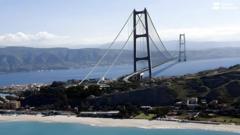The Italian government has officially approved a monumental €13.5 billion ($15.6 billion) project to construct what is set to be the longest suspension bridge in the world, bridging Sicily and Calabria at the Mediterranean's Messina Strait. Despite facing historical setbacks—ranging from budgetary concerns to environmental implications—officials advocate for the bridge as a symbol of progress and economic development.
Prime Minister Giorgia Meloni championed the venture on Wednesday, emphasizing its significance as an "investment in Italy's present and future." This iteration of the bridge plan aims to address seismic safety concerns, given the region's vulnerability to earthquakes, boasting designs to withstand such natural events. The bridge will span 3.3 kilometers (2.05 miles) and feature railway lines flanked by three traffic lanes on either side, all supported by two towering structures rising 400 meters (1,300 feet) above the strait.
Transport Minister Matteo Salvini, a key figure in Meloni's government, heralded the bridge's approval as a transformational project that could create approximately 120,000 jobs annually and stimulate the economy in Sicily and Calabria—regions that are among the poorest in Europe. He expressed hopes for completion between 2032 and 2033, while also exploring the possibility of categorizing the bridge as a military expenditure to meet NATO defense spending commitments.
Nonetheless, the project requires further endorsements from the Italian Court of Auditors and environmental agencies at both national and EU levels. It faces potential resistance from local communities, as property expropriation concerns loom large. Residents could challenge the decision legally, with a history of mistrust surrounding previous plans stemming back over 50 years, many of which suffered from allegations involving corruption linked to local mafia networks.
Critics, particularly from local political factions, have voiced strong opposition. Senator Nicola Irto from the Democratic Party termed the project "controversial and divisive," arguing it threatens to misallocate essential resources from local infrastructure needs like public transport, education, and healthcare. Giusy Caminiti, Mayor of Villa San Giovanni, near the projected site, expressed her concerns over the project’s impact on local communities, pleading for further consultations before proceeding.
Grassroots movements opposing the bridge, such as the "No to the Bridge" committee, reiterated claims that the decision lacks thorough technical evaluation and could exacerbate the ongoing water scarcity issues faced in both Sicily and Calabria. Currently, train passengers must rely on ferries for transport across the strait, a journey taking approximately 30 minutes.
As Italy stands at the threshold of this ambitious infrastructure endeavor, the path ahead remains fraught with debate over priorities, regional needs, and concerns of environmental impact versus economic opportunity.
Prime Minister Giorgia Meloni championed the venture on Wednesday, emphasizing its significance as an "investment in Italy's present and future." This iteration of the bridge plan aims to address seismic safety concerns, given the region's vulnerability to earthquakes, boasting designs to withstand such natural events. The bridge will span 3.3 kilometers (2.05 miles) and feature railway lines flanked by three traffic lanes on either side, all supported by two towering structures rising 400 meters (1,300 feet) above the strait.
Transport Minister Matteo Salvini, a key figure in Meloni's government, heralded the bridge's approval as a transformational project that could create approximately 120,000 jobs annually and stimulate the economy in Sicily and Calabria—regions that are among the poorest in Europe. He expressed hopes for completion between 2032 and 2033, while also exploring the possibility of categorizing the bridge as a military expenditure to meet NATO defense spending commitments.
Nonetheless, the project requires further endorsements from the Italian Court of Auditors and environmental agencies at both national and EU levels. It faces potential resistance from local communities, as property expropriation concerns loom large. Residents could challenge the decision legally, with a history of mistrust surrounding previous plans stemming back over 50 years, many of which suffered from allegations involving corruption linked to local mafia networks.
Critics, particularly from local political factions, have voiced strong opposition. Senator Nicola Irto from the Democratic Party termed the project "controversial and divisive," arguing it threatens to misallocate essential resources from local infrastructure needs like public transport, education, and healthcare. Giusy Caminiti, Mayor of Villa San Giovanni, near the projected site, expressed her concerns over the project’s impact on local communities, pleading for further consultations before proceeding.
Grassroots movements opposing the bridge, such as the "No to the Bridge" committee, reiterated claims that the decision lacks thorough technical evaluation and could exacerbate the ongoing water scarcity issues faced in both Sicily and Calabria. Currently, train passengers must rely on ferries for transport across the strait, a journey taking approximately 30 minutes.
As Italy stands at the threshold of this ambitious infrastructure endeavor, the path ahead remains fraught with debate over priorities, regional needs, and concerns of environmental impact versus economic opportunity.




















